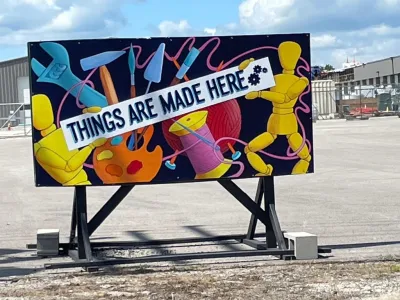A focus on small businesses is helping a commercial corridor in Columbia, Missouri thrive.

A commercial corridor along a state highway in Columbia, Missouri has become a model for revitalization after a targeted economic development effort that turned a nondescript strip into a community destination.
Ilana Preuss describes the project, known as The Loop, in a piece for Next City, profiling Carrie Gartner and the Loop Community Improvement District, which spearheaded the project. According to Preuss, the project area “wasn’t downtown. There was no place to hang out. Buildings were pushed back from the road. Traffic was full of trucks cutting through. Sidewalks, where they existed, were cracked and inconsistent.”
Gartner’s strategy focused on anchoring the area with small-scale manufacturing that would draw entrepreneurs without relying on foot traffic. “Second, she figured out how to attract people to the area – to spend time there rather than just driving through. She approached the local electricity co-op about its empty parking lot, organized donations of shipping containers and picnic tables, and brought together 200 volunteers to create a pop-up park.”
The CID also led a campaign to rezone the area to make it more accommodating for the types of businesses coming in. “ The Loop’s strategic focus on small-scale manufacturing businesses and their needs, and extensive conversations with local leaders, to the success of the rezoning campaign in 2021 that approved shared production spaces up to 15,000 square feet.”
Thanks to the focus on amenities that support the growth of small businesses, Preuss writes, The Loop is “becoming a place to stop in, get work done, a place where entrepreneurs from different parts of the city can learn and create together.”
FULL STORY: Turning a Neglected State Roadway Into an Economic Engine

Study: Maui’s Plan to Convert Vacation Rentals to Long-Term Housing Could Cause Nearly $1 Billion Economic Loss
The plan would reduce visitor accommodation by 25,% resulting in 1,900 jobs lost.

North Texas Transit Leaders Tout Benefits of TOD for Growing Region
At a summit focused on transit-oriented development, policymakers discussed how North Texas’ expanded light rail system can serve as a tool for economic growth.

Why Should We Subsidize Public Transportation?
Many public transit agencies face financial stress due to rising costs, declining fare revenue, and declining subsidies. Transit advocates must provide a strong business case for increasing public transit funding.

How to Make US Trains Faster
Changes to boarding platforms and a switch to electric trains could improve U.S. passenger rail service without the added cost of high-speed rail.

Columbia’s Revitalized ‘Loop’ Is a Hub for Local Entrepreneurs
A focus on small businesses is helping a commercial corridor in Columbia, Missouri thrive.

Invasive Insect Threatens Minnesota’s Ash Forests
The Emerald Ash Borer is a rapidly spreading invasive pest threatening Minnesota’s ash trees, and homeowners are encouraged to plant diverse replacement species, avoid moving ash firewood, and monitor for signs of infestation.
Urban Design for Planners 1: Software Tools
This six-course series explores essential urban design concepts using open source software and equips planners with the tools they need to participate fully in the urban design process.
Planning for Universal Design
Learn the tools for implementing Universal Design in planning regulations.
City of Santa Clarita
Ascent Environmental
Institute for Housing and Urban Development Studies (IHS)
City of Grandview
Harvard GSD Executive Education
Toledo-Lucas County Plan Commissions
Salt Lake City
NYU Wagner Graduate School of Public Service





























